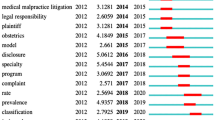Abstract
We model the interactions between the behaviors of physicians and patients, subject to clinical and legal risks, by means of evolutionary game theory. We propose an original game in which patients may sue their physician for medical malpractice, and physicians have to choose between two alternative treatments, with different levels of benefits and risks. The safer treatment is also the less effective, therefore its provision corresponds, under the assumptions of our model, to practicing negative defensive medicine. We study the Nash equilibria, test their stability in the replicator dynamics, and analyze their welfare properties. We find that the accuracy of the judicial system plays an important role, with possible counter-intuitive effects related to legal reforms. If the court is not sufficiently accurate, defensive medicine can be favored, paradoxically, by an increase in the probability that defensive physicians are sanctioned by the court. A similar outcome can be generated also by an increase in the compensation paid to patients by physicians, when sanctioned for medical malpractice.



Similar content being viewed by others
Notes
References
Allard M, Léger PT, Rochaix L (2009) Provider competition in a dynamic setting. J Econ Manage Strat 18:457–486
Antoci A, Fiori Maccioni A, Russu P (2016) The ecology of defensive medicine and malpractice litigation. PLoS One 11(3):e0150523. https://doi.org/10.1371/journal.pone.0150523
Avraham R, Schanzenbach M (2010) The impact of tort reform on private health insurance coverage. Am Law Econ Rev 12:319–355
Baker T (2004) Medical malpractice and the insurance underwriting cycle. DePaul L Rev 54:393–438
Black B, Silver C, Hyman DA, Sage WM (2005) Stability, not crisis: medical malpractice claim outcomes in Texas, 1988-2002. J Empirical Legal Stud 2:207–259
Currie J, MacLeod WB (2008) First do no harm? Tort reform and birth outcomes. Q J Econ 123:795–830
Danzon PM (1991) Liability for medical malpractice. J Econ Perspect 5:51–69
Danzon PM, Epstein AJ, Johnson SJ (2004) The crisis in medical malpractice insurance. Brookings-Wharton pap financ serv 1:55–96
Dubay L, Kaestner R, Waidmann T (1999) The impact of malpractice fears on cesarean section rates. J Health Econ 18:491–522
Dubay L, Kaestner R, Waidmann T (2001) Medical malpractice liability and its effect on prenatal care utilization and infant health. J Health Econ 20:591–611
Ellis RP (1998) Creaming, skimping and dumping: provider competition on the intensive and extensive margins. J Health Econ 17:537–555
Ellis RP, McGuire TG (1986) Provider behavior under prospective reimbursement: cost sharing and supply. J Health Econ 5:129–151
Feess E (2012) Malpractice liability, technology choice and negative defensive medicine. Eur J Health Econ 13:157–167
Gal-Or E (1999) Optimal reimbursement and malpractice sharing rules in health care markets. J Regul Econ 16:237–266
Hofbauer J, Sigmund K (1998) Evolutionary games and population dynamics. Cambridge University Press, Cambridge
Jena AB, Seabury S, Lakdawalla D, Chandra A (2011) Malpractice risk according to physician specialty. New Eng J Med 365:629–636
Kessler DP (2004) The Effects of the U.S. Malpractice System: A Review of the Empirical Literature. Working Paper. New York: Manhattan Institute. http://www.pointoflaw.com/pdfs/kessler-malpractice-jced1.pdf. Accessed 23 July 2017
Kessler D, McClellan M (1996) Do doctors practice defensive medicine? Q J Econ 111:353–390
Lien HM, Ma CTA, McGuire TG (2004) Provider-client interactions and quantity of health care use. J Health Econ 23:1261–1283
Localio AR, Lawthers AG, Bengtson JM, Hebert LE, Weaver SL, Brennan TA et al. (1993) Relationship between malpractice claims and cesarean delivery. JAMA 269:366–373
Ma CTA (1994) Health care payment systems: cost and quality incentives. J Econ Manage Strat 3:93–112
Ma CTA, McGuire TG (1997) Optimal health insurance and provider payment. Am Econ Rev 87:685–704
Madarász K (2012) Information projection: model and applications. Rev Econ Stud 79:961–985
Maynard Smith J (1982) Evolution and the theory of games. Cambridge University Press, Cambridge
Mello MM, Kachalia A (2010) Evaluation of options for medical malpractice system reform. MedPAC Report 10-02, Washington
Mello MM, Chandra A, Gawande AA, Studdert DM (2010) National costs of the medical liability system. Health Aff 29:1569–1577
Olbrich A (2008) Heterogeneous physicians, lawsuit costs, and the negligence rule. Int Rev Law Econ 28:78–88
Quinn R (1998) Medical malpractice insurance: the reputation effect and defensive medicine. J Risk Insur 65:467–484
Rodwin MA, Chang HJ, Ozaeta MM, Omar RJ (2008) Malpractice premiums in Massachusetts, a high-risk state: 1975 to 2005. Health Aff 27:835–844
Sloan FA, Shadle JH (2009) Is there empirical evidence for defensive medicine? A reassessment. J Health Econ 28:481–491
Studdert DM et al. (2005) Defensive medicine among high-risk specialist physicians in a volatile malpractice environment. JAMA 293:2609–2617
Summerton N (1995) Positive and negative factors in defensive medicine: a questionnaire study of general practitioners. BMJ 310:27–29
Tancredi LR, Barondess JA (1978) The problem of defensive medicine. Science 200:879–882
Taylor PD (1979) Evolutionary stable strategies with two types of player. J Appl Probab 16:76–83
U.S. General Accounting Office (1986) Medical malpractice: six state case studies show claims and insurance costs still rise despite reforms. GAO/HRD-87-21, Washington
Vidmar N, Wolfe M (2009) Punitive damages. Annu Rev Law Soc Sci 5:179–199
Vincent C, Phillips A, Young M (1994) Why do people sue doctors? A study of patients and relatives taking legal action. Lancet 343:1609–1613
Weibull JW (1997) Evolutionary game theory. MIT Press, Cambridge
Author information
Authors and Affiliations
Corresponding author
Ethics declarations
A. Antoci and P. Russu received research grants from Regione Autonoma della Sardegna (L.R. 7/2007) under the project ‘Capitale sociale e divari economici regionali’. A. Fiori Maccioni received research grants from P.O.R. FSE Sardegna 2007/13 under the project ‘Risk Management System per aziende sanitarie’.
Conflict of interests
The authors declare that the funding sources had no involvement in the research and have no conflicts of interest.
Rights and permissions
About this article
Cite this article
Antoci, A., Fiori Maccioni, A. & Russu, P. Medical practice and malpractice litigation in an evolutionary context. J Evol Econ 28, 915–928 (2018). https://doi.org/10.1007/s00191-018-0578-0
Published:
Issue Date:
DOI: https://doi.org/10.1007/s00191-018-0578-0




